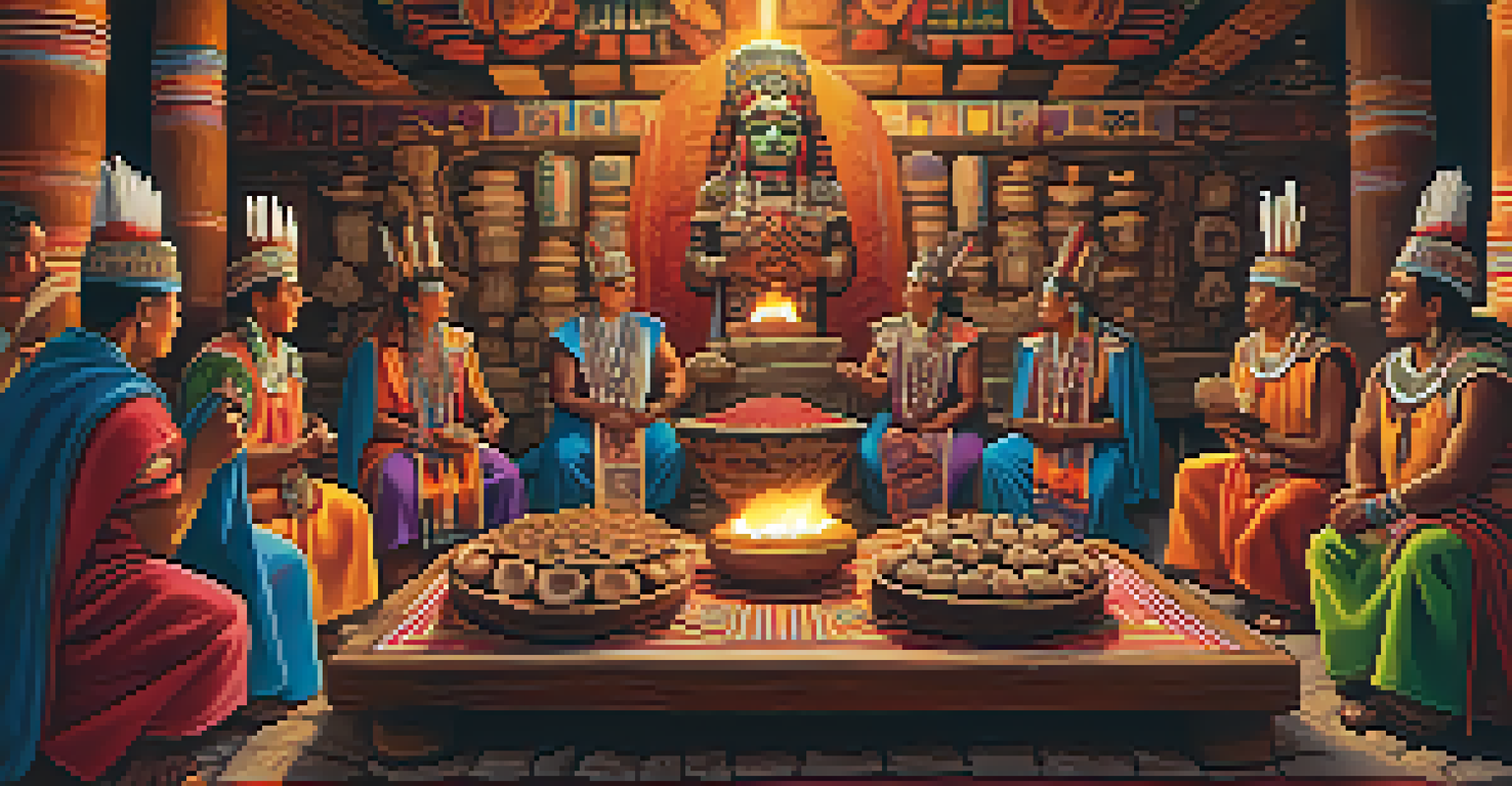Entheogens in Ancient Rituals: A Historical Overview

Understanding Entheogens and Their Historical Context
Entheogens are substances that are used in a religious or spiritual context to facilitate a deeper connection to the divine. These natural compounds often include plants and fungi that induce altered states of consciousness. Historically, they have played a significant role in various cultures, acting as mediums for communication with the spiritual world.
The experience of the divine is a profound engagement with the inner self, often facilitated by nature's gifts.
The term 'entheogen' itself comes from the Greek words meaning 'to generate the divine within.' This concept underscores the belief that these substances can unlock profound spiritual experiences. Ancient civilizations, from the Mayans to the Greeks, utilized these potent tools to enhance their rituals, seeking enlightenment or guidance.
Understanding the historical context of entheogens helps us appreciate their significance in ancient practices. Their use was often intertwined with cultural identity, religious ceremonies, and community bonding, illustrating how these substances were more than mere drugs—they were pivotal to the fabric of society.
Entheogens in Indigenous Cultures: A Deep Connection
Many indigenous cultures around the world have long histories of using entheogens in their spiritual traditions. For instance, the Amazonian tribes have relied on ayahuasca, a brew made from local plants, for centuries as a means of healing and connecting with their ancestors. This practice demonstrates the strong bond between nature and spirituality that these communities uphold.

In North America, the Native American Church incorporates peyote, a cactus with psychoactive properties, into its religious ceremonies. The use of peyote is seen as a sacred duty, allowing participants to gain insight, healing, and a sense of unity with the universe. These examples highlight how entheogens serve not only as spiritual tools but also as vital components of cultural heritage.
Entheogens in Spiritual Traditions
Entheogens have historically served as important tools for spiritual connection and community bonding across various cultures.
The reverence for these substances in indigenous cultures points to a deep understanding of the natural world. By engaging with entheogens, practitioners often report transformative experiences that emphasize the importance of community, tradition, and a profound connection to the earth.
The Role of Entheogens in Ancient Greek Mysteries
The ancient Greeks held elaborate mystery schools, such as the Eleusinian Mysteries, where entheogens were a key component. Participants would consume a special drink called kykeon, believed to contain psychoactive ingredients that induced mystical experiences. This practice was shrouded in secrecy, with initiates claiming profound revelations about life and death.
Psychedelic substances can be a powerful tool for spiritual growth, connecting us to the ancient wisdom of our ancestors.
The initiation into these mysteries was not just a rite of passage, but an opportunity to experience a deeper understanding of the cosmos. The transformative effects of the entheogens used in these rituals fostered a sense of unity among participants, connecting them to each other and the divine. This highlights how such experiences can transcend individual understanding and create communal bonds.
The Greek use of entheogens reflects a broader human desire to seek knowledge and connection beyond the mundane. Their rituals illustrate how these substances can unlock hidden truths, allowing practitioners to glimpse the mysteries of existence.
Mesoamerican Cultures and Their Sacred Plants
Mesoamerican cultures, such as the Aztecs and the Mayans, revered various plants for their psychoactive properties. The use of mushrooms and cacao in rituals was common, with these substances believed to facilitate communication with gods and ancestors. This relationship with sacred plants illustrates the intertwining of spirituality and agriculture in these societies.
For example, the Aztecs called mushrooms 'teonanácatl,' meaning 'flesh of the gods.' This reflects the belief that consuming these mushrooms would provide divine insight and wisdom. Similarly, cacao was not only a source of nourishment but also a vehicle for spiritual experiences during ceremonies, emphasizing its dual role in society.
Cultural Significance of Sacred Plants
Indigenous cultures regard entheogens, like ayahuasca and peyote, as vital components of their spiritual practices and cultural heritage.
The significance of these plants goes beyond mere consumption; they were integral to the cultural identity and religious practices of Mesoamerican peoples. Through these rituals, communities fostered a deep appreciation for the natural world and its gifts, reinforcing their spiritual beliefs.
Entheogenic Practices in Ancient Egyptian Rituals
Ancient Egypt is often associated with a rich tapestry of rituals and spiritual practices, many of which included the use of entheogens. Evidence suggests that substances like blue lotus were used to induce altered states of consciousness during religious ceremonies. This plant was revered for its psychoactive effects and was often linked to the divine.
The blue lotus, known for its calming properties, was believed to facilitate communication with gods and foster spiritual awakening. Its use in rituals highlights how ancient Egyptians sought to connect with the divine through sensory experiences, blurring the line between the physical and spiritual realms.
These practices reveal a sophisticated understanding of the mind-body connection in ancient Egyptian culture. By incorporating entheogens into their rituals, they sought not only personal enlightenment but also communal harmony, creating a profound sense of belonging within their spiritual framework.
The Shift in Perception: From Sacred to Forbidden
As societies evolved, the perception of entheogens began to shift dramatically. What was once considered sacred and integral to spiritual practices eventually faced scrutiny and prohibition, particularly during the rise of organized religions. The demonization of these substances often stemmed from a desire to control spiritual experiences and maintain societal order.
In many cultures, the use of entheogens was repressed, leading to a loss of traditional knowledge and practices. This shift illustrates how the relationship between humans and these substances became fraught with stigma, distancing people from the spiritual benefits they once provided. The consequences of this shift are still felt today, as many seek to reclaim these ancient practices.
Modern Interest in Ancient Practices
There is a growing contemporary interest in entheogens for healing and spiritual growth, reflecting a desire to reconnect with ancient wisdom.
Despite the challenges, there has been a resurgence of interest in entheogens in recent years. Many individuals are now exploring their potential for healing and spiritual growth, echoing the ancient practices of their ancestors. This evolving perspective is a testament to the enduring power of entheogens in human culture.
Modern Resurgence: Entheogens in Contemporary Spirituality
In recent years, there has been a renewed interest in the use of entheogens within contemporary spirituality. Practices such as guided ayahuasca retreats and psilocybin therapy are gaining traction as individuals seek deeper meaning and healing. This modern resurgence reflects a desire to reconnect with the ancient wisdom that these substances can offer.
People are increasingly recognizing the therapeutic potential of entheogens, especially in treating mental health issues like depression and anxiety. Scientific research supports these claims, revealing that guided experiences can lead to profound personal insights and emotional breakthroughs. This has sparked a broader conversation about the role of entheogens in personal and collective healing.

As society embraces these ancient practices, it also opens the door to discussions about ethical and responsible use. The challenge lies in honoring the traditions of indigenous cultures while integrating these practices into modern spirituality. This ongoing dialogue emphasizes the importance of respecting the roots of entheogens while exploring their potential in today's world.